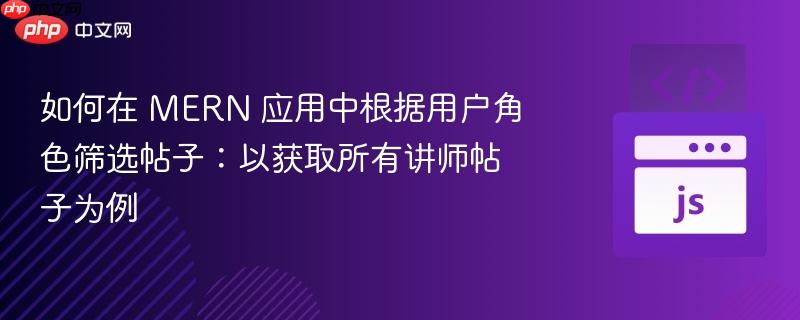
在构建mern(mongodb, express, react, node.js)堆栈应用程序时,经常需要根据用户属性(如角色)来筛选或限制内容的访问。例如,在一个学习平台中,可能需要展示所有由“讲师”角色用户发布的帖子。本文将详细阐述如何通过mongoose实现这一功能,并提供具体的代码示例。
首先,我们需要审视应用程序中的Post和User数据模型。这些模型定义了数据的结构和它们之间的关系。
Post 模型包含帖子的基本信息,并与 User 模型建立了关联,表示哪个用户发布了该帖子。
import mongoose from 'mongoose';
const PostSchema = new mongoose.Schema(
{
title: {
type: String,
required: true,
},
text: {
type: String,
required: true,
unique: true,
},
tags: {
type: Array,
default: [],
},
viewsCount: {
type: Number,
default: 0,
},
user: {
type: mongoose.Schema.Types.ObjectId,
ref: 'User', // 引用 User 模型
required: true,
},
imageUrl: String,
comments: [{ type: mongoose.Schema.Types.ObjectId, ref: 'Comment' }],
},
{
timestamps: true,
},
);
export default mongoose.model('Post', PostSchema);请注意 user 字段,它是一个 mongoose.Schema.Types.ObjectId 类型,并通过 ref: 'User' 指向 User 模型。这意味着每个帖子都关联到一个特定的用户。
User 模型定义了用户的属性,其中关键的是 role 字段,它明确了用户的身份(学生或讲师)。
import mongoose from "mongoose";
const UserSchema = new mongoose.Schema({
fullName: {
type: String,
required:true,
},
email: {
type: String,
required:true,
unique: true,
},
passwordHash: {
type: String,
required: true,
},
role: {
type: String,
enum: ["student", "instructor"], // 定义用户角色枚举
required: true,
},
avatarUrl: String,
},
{
timestamps: true,
});
// 可以添加实例方法来检查角色
UserSchema.methods.isStudent = function () {
return this.role === "student";
};
UserSchema.methods.isInstructor = function () {
return this.role === "instructor";
};
export default mongoose.model('User', UserSchema);role 字段是一个字符串,其值被限制为 "student" 或 "instructor"。这是我们进行筛选的关键属性。
一个常见的错误尝试是直接在 Post 模型的查询中加入 role 字段的条件,例如:
// 错误的尝试
export const getAllByTeacher = async(req, res) => {
try {
// Post 模型本身没有 role 字段
const posts = await PostModel.find({role: "instructor"}).populate('user').exec();
res.json(posts);
} catch (e) {
console.log(e);
res.status(500).json({
message: 'Can not get post'
});
}
}这种方法之所以错误,是因为 Post 模型本身并没有 role 字段。role 字段存在于 User 模型中。Mongoose 的 find 方法在执行查询时,是针对当前模型的字段进行匹配的。虽然 populate('user') 可以在查询结果返回后将关联的用户数据填充进来,但它并不能在初始的 find 查询阶段,根据被关联模型(User)的字段来过滤当前模型(Post)的数据。
要正确地根据用户角色筛选帖子,我们需要采取两步走策略:
以下是具体的实现代码:
import PostModel from '../models/Post.js'; // 假设你的 Post 模型在此路径
import UserModel from '../models/User.js'; // 假设你的 User 模型在此路径
export const getAllByInstructor = async (req, res) => {
try {
// 1. 查找所有角色为“instructor”的用户
const instructors = await UserModel.find({ role: "instructor" }, '_id'); // 仅获取 _id 字段
// 提取这些讲师的 ID 列表
// instructors 数组现在包含 { _id: '...' } 形式的对象
// 通过 .map 提取纯粹的 ID 字符串或 ObjectId 对象
const instructorIds = instructors.map(user => user._id);
// 2. 使用讲师的 ID 列表查询所有由他们发布的帖子
// $in 操作符用于匹配 user 字段在 instructorIds 数组中的任何一个值
const posts = await PostModel.find({ user: { $in: instructorIds } })
.populate('user') // 填充关联的用户信息
.exec();
res.json(posts);
} catch (err) {
console.error(err); // 使用 console.error 打印错误
res.status(500).json({
message: '无法获取讲师的帖子',
});
}
};通过上述方法,我们成功解决了在 MERN 应用中根据用户角色筛选帖子的挑战。关键在于理解 Mongoose 的查询机制和模型关联,并采取分步查询的策略:首先识别出目标用户,然后利用这些用户的ID来精确地检索相关内容。这种模式是处理 Mongoose 中关联数据筛选的强大且灵活的方式。
以上就是如何在 MERN 应用中根据用户角色筛选帖子:以获取所有讲师帖子为例的详细内容,更多请关注php中文网其它相关文章!

每个人都需要一台速度更快、更稳定的 PC。随着时间的推移,垃圾文件、旧注册表数据和不必要的后台进程会占用资源并降低性能。幸运的是,许多工具可以让 Windows 保持平稳运行。

Copyright 2014-2025 https://www.php.cn/ All Rights Reserved | php.cn | 湘ICP备2023035733号